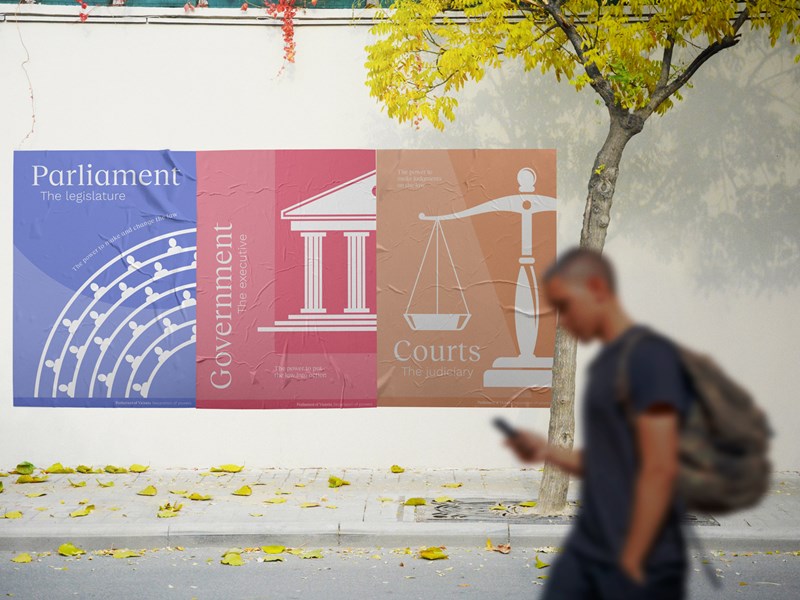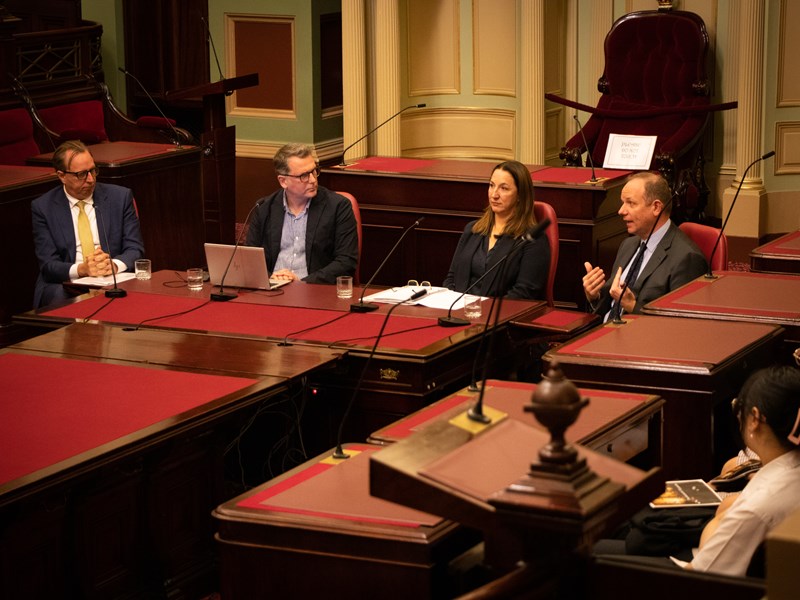A closer look at the separation of powers
17 March 2023

Teachers from across Victoria joined us online and in person at Parliament House recently, for our latest professional development session delivered in collaboration with Victoria Law Foundation.
Exploring concepts relating to the separation of powers, participants heard from representatives of the courts, government and parliament: Judge Elizbeth Brimer, Matt Fregon MP, and Legislative Council Clerk Robert McDonald. The panel talked about the responsibilities of each administrative branch, how they interact with each other, and their respective accountability functions.

Checks and balances
The separation of powers in Victoria, as in any democratic system, is a fundamental principle that supports the democratic process by ensuring that no single person or group has too much power or influence.
The separation of powers in Victoria is based on the idea that different branches of government—the legislature (parliament), the executive (government) and the judiciary (the courts)—should have distinct and independent powers and responsibilities.
In Victoria, the separation of powers is reflected in the Constitution Act 1975, which establishes the three separate branches of government. Each branch has its own unique powers and responsibilities, and they are designed to act as checks and balances on each other.
One of the most common misunderstandings about the separation of powers is the difference between parliament and government. In Victoria, parliament consists of all 128 members regardless of their political affiliations. While parliament is responsible for making laws—ensuring the processes and rules have been followed—government is responsible for proposing the laws and administering the necessary policies to run the state. The government is formed by a political party that may change after an election, and the composition of parliament may change, but the general principles that guide the processes and rules of making a law change slowly over time.
The role of the legislature
The role of the legislature is to make laws. The legislature consists of the 128 members of parliament (88 MPs in the Legislative Assembly and 40 in the Legislative Council) and includes ministers, backbenchers, shadow ministers, crossbenchers and independents. All members of parliament can introduce bills (proposed laws), but new laws are mostly proposed by the executive (government) which includes the premier and cabinet members. When a member of parliament who is not part of the government proposes a bill, it is called a private member’s bill.
Passing a bill through parliament
In order for a law to be passed in parliament, it must go through three stages in both houses: the first reading, second reading, and third reading.
The first reading is usually unopposed and is just an introduction to the bill.
During the second reading, the member who introduced the bill will give a speech explaining the intention of the bill. This speech is normally written in full to ensure accuracy and it is recorded in the parliamentary record called Hansard. The bill is then debated in detail and can go through various stages of consideration and amendment.
The third reading is the vote, and it sometimes may include more time for debate.
Once it has gone through this process and passed both houses, the bill goes to the Governor for Royal Assent to become an Act of Parliament, and therefore a law.
If there is no support for a bill, there are several options.
- Amend the bill
Amendments are made during the second reading can be proposed by any member of the house and may be based on different party policy, technical changes that have been identified or feedback from external sources. Each amendment made to the bill is also voted on by the members of house. Both houses have a process for debating amendments. In the Legislative Assembly it’s called Consideration in detail and in the Legislative Council it’s called Committee of the Whole. During this process, each clause of the bill is read. As each clause is read, members can propose amendments, there is an opportunity for debate of the amendments and the house votes before moving onto the next clause. - Take the bill off the legislative agenda
This may provide an opportunity to revise or reshape the bill based on feedback or different policy initiatives so it can be reintroduced at a later date.
- Let the bill go to a vote
There may be a risk that it will be defeated
The role of the executive
In Victoria, the executive branch refers to the premier and cabinet, which is made up of members of the government who have portfolios such as Education, Health, Transport or Environment. The executive introduces most bills into the parliament, which are then debated by all members of the house.
The role of the judiciary
The judiciary in Victoria is an independent branch, separate from the executive and the parliament. Judges and magistrates in courts decide cases according to the law, including interpreting legislation or determining the lawfulness of decisions.
During the law-making process, the judiciary stays at arm's length and only interprets the law or reviews decisions that have been made. They do not involve themselves in policy aspects, which is left to the executive arm of the government.
The judiciary is considered to have true independence despite being appointed by the executive because they cannot be removed by the executive. There is a separate process to remove judges, which ensures that they can interpret and apply the law fearlessly. The independence of the judiciary in Australia is maintained through a level of respect between the pillars of government, conventions, and the constitution.